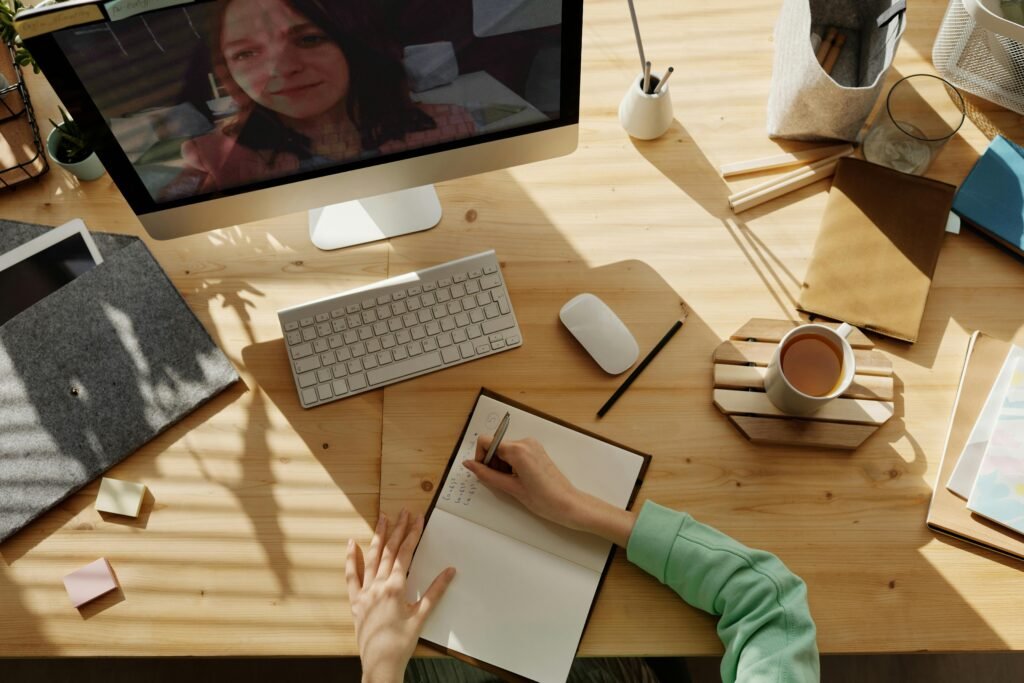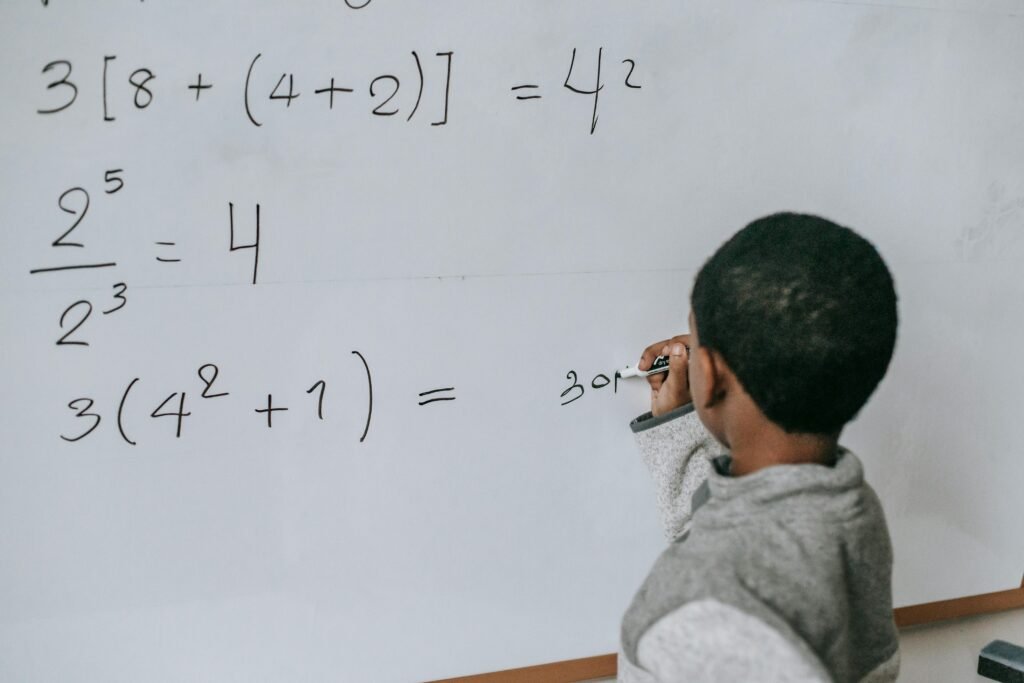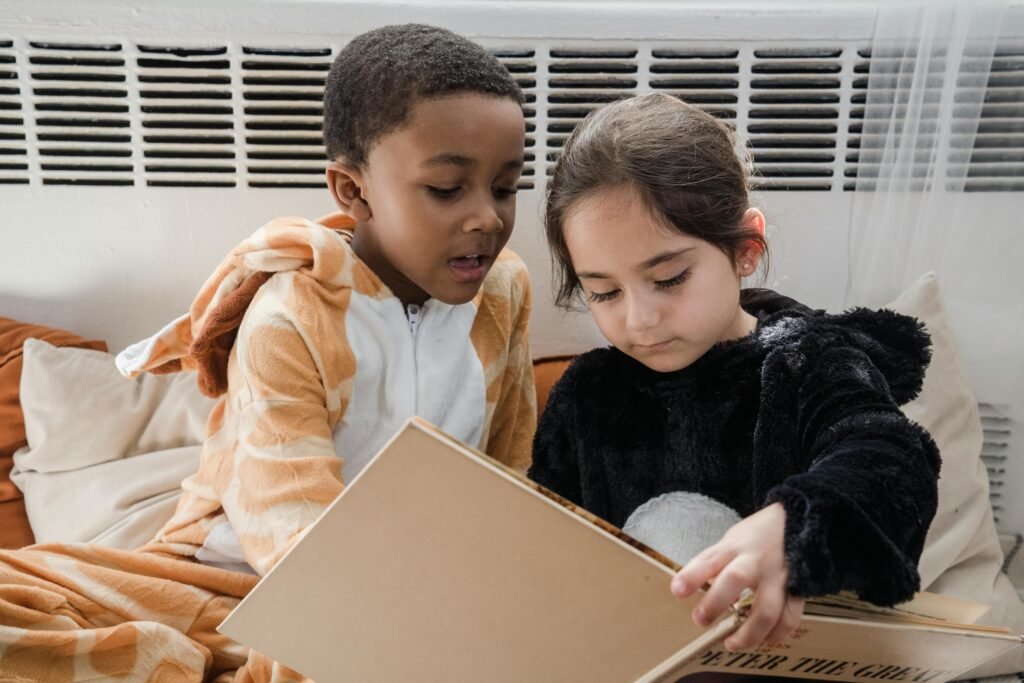Screens are everywhere. At school. At home. Even on the way to school. Whether your child is watching a lesson, doing homework, or just relaxing after class—chances are, they’re looking at a screen. But how much is too much? And what’s the real difference between screen time for kids learning online vs those learning in person?
Students attending online school spend an average of 4.5–6 hours per day on screens for schoolwork
Let’s start with this big number: online students often spend between 4.5 to 6 hours every single day just on screens for schoolwork. That’s almost a full workday—just staring at a screen. Now imagine being a child, expected to stay still, focus, and learn during all that time. That’s tough.
When school moved online, most of the learning moved to screens too. Teachers started using video calls, slideshows, digital worksheets, and even online tests. This made things easier in some ways, but it also meant students now had to sit longer in front of computers.
Here’s the problem. Kids learn best when they can move, talk, ask questions, and use their hands. But with screen-based learning, they’re often just sitting and watching. This can cause fatigue. It can reduce focus. And it can make learning feel more like a chore than an adventure.
As a parent, you may have noticed this. Maybe your child complains about being tired, bored, or even getting headaches. That’s because long hours on screens don’t just tire their eyes—they tire the brain too.
What can you do about it? Start by breaking the screen hours into chunks. If your child has a 2-hour block of online learning, pause every 25–30 minutes. Let them stretch, walk, or get a drink. You can also switch some learning tasks to paper. If they’re reading a story, print it out. If they’re doing math, let them use a notebook instead of typing.
And if your child is on Debsie, you’ll find our platform is designed with this in mind. We make screen time interactive, with games, rewards, and challenges that keep the brain and body engaged. It’s not about staring—it’s about learning with action.
Remember, it’s not just how long kids are on screens. It’s what they’re doing there that matters most.
In-person students spend an average of 1.5–2.5 hours per day on screens for educational purposes
Now let’s look at the other side. Students who go to school in person still use screens—but for much less time. On average, they spend about 1.5 to 2.5 hours per day using screens for schoolwork. That’s often just for short research tasks, videos, or typing up work.
This difference matters. Less screen time means more chances to use books, talk with classmates, play with real objects, and move around. In-person school naturally includes more breaks, more variety, and more personal interaction. That’s good for focus and memory.
That said, screens are still part of in-person learning today. Many schools have digital whiteboards, Chromebooks, or iPads. But because they are used alongside hands-on activities, the screen time is better balanced. Students aren’t sitting still for long periods. They get up, move around, and interact with teachers and peers face-to-face.
For parents of in-person learners, this stat is reassuring. But there’s still something you can do to make it even better. Ask your child how they’re using screens at school. If they’re using devices for most subjects, try to balance it at home. Encourage book reading, puzzles, drawing, or outdoor play after school.
If your child is doing hybrid learning—or if they do online classes part of the week—keep this 1.5–2.5 hours number in mind. Use it as a goal. Try to keep total screen time for schoolwork under that limit when possible. And if they go beyond it, make sure there are active breaks in between.
Debsie also supports screen balance by giving learners a mix of offline challenges they can do with their hands—not just their eyes. It’s one way we support full-body learning that keeps kids moving, thinking, and smiling.
Online students experience a 35% increase in daily screen time compared to in-person learners
Here’s where the numbers really stand out. On average, students in online school spend 35% more screen time each day than those who go to school in person. That’s a big jump. Over time, this extra screen time adds up—and so do the effects.
Why is this such a big deal? Because more screen time doesn’t just mean more learning. In fact, too much screen time can actually reduce how well kids learn. It can cause more eye strain. It can make it harder for them to sleep. And it can lead to shorter attention spans.
Think about it. If you’re looking at a screen for 6 hours a day just for lessons, and then another 2–3 hours for homework or entertainment, you’re spending most of your day with your eyes fixed on a screen. That’s not how kids were meant to learn or grow.
The good news? You can reduce the impact of this 35% increase. Start by scheduling screen-free times during the day. Maybe after lunch, you go for a short walk. Or after school ends, there’s a “tech-free hour” where everyone reads, plays, or talks.
You can also look at your child’s online learning tools. Some platforms are more interactive and less stressful than others. At Debsie, for example, we use audio prompts, animations, and real-world tasks to keep kids engaged—without needing them to click or stare constantly.
Even small changes can help. Lower the screen brightness. Turn on blue light filters. Use larger fonts. And most importantly, talk to your child. Ask them how they feel after their classes. Listen to what their body is telling you. If they’re tired, it’s time to take action.
Children doing online lessons spend 80% of their learning time on digital devices
Here’s another stat that’s worth thinking about. When children learn online, around 80% of their learning time is spent on digital devices. That means the laptop, tablet, or desktop is the main tool for almost everything they do in school.
Compare that to in-person classes, where kids use books, whiteboards, science tools, and more. The difference is huge.
Spending 80% of time on a device means less hands-on work. Fewer group projects. Less physical movement. And not much variety in how information is presented. This can lead to mental tiredness and even boredom, even when the content is good.
Kids need to touch, build, move, and experiment. That’s how real learning happens. When everything is digital, it becomes flat. It loses that spark. And that’s why many kids struggle to stay interested in long online lessons.
But here’s what you can do. Turn that 80% into a more balanced number. After your child finishes a screen-based lesson, ask them to show you what they learned in a physical way. If it’s a science topic, ask them to do a small experiment. If it’s a story, have them draw a scene from it. If it’s math, use coins, blocks, or kitchen items to model it.
At Debsie, we blend screen time with screen breaks. Many of our challenges encourage children to step away and do something fun or creative with their hands. This keeps the brain fresh and makes learning stick better.
Digital tools are powerful. But they should support learning—not become the whole experience.
In-person learners only use screens for about 30% of class activities
Here’s some good news about in-person schooling: students only use screens for about 30% of classroom activities. That’s less than one-third of their learning time. The rest is done using books, notebooks, group discussions, real-life projects, and hands-on tools.
This smaller screen percentage gives children a huge advantage. It allows for more face-to-face interaction with teachers and classmates. It also means more chances to ask questions, get immediate help, and connect ideas with real-world actions.
Using screens for just a portion of learning can actually be very effective. For example, watching a short video or looking at a diagram online can help explain things better. But when that’s followed by a group project, a class debate, or solving a problem on paper—it’s much more powerful.
If your child is in in-person school, it’s still important to check how screens are used. Some schools use devices all day long, which pushes that 30% much higher. Ask your child what they did during the day. If you hear things like “we were on our iPads the whole time,” it might be a sign to talk to the teacher.
And if your child does online learning, you can still aim for this 30% model. Just because school is online doesn’t mean every learning moment has to happen on a screen. Use screen time to introduce new ideas, and then move into offline activities. Write by hand. Build something. Talk it out loud. Draw a picture. These are all forms of learning, too.
At Debsie, we believe in this balance. Even though we’re an online platform, we design our activities so kids get away from the screen as often as possible. Because sometimes the best learning happens when the screen turns off.
Online schooling can increase total screen exposure to 8–10 hours a day when including homework and entertainment
Let’s talk about the full picture. Online schooling doesn’t just mean screen time for lessons. It often leads to 8–10 hours a day of total screen exposure—once you add homework, video games, YouTube, and other digital entertainment.
That’s a full day of screen time. And it’s a lot for any child’s eyes, brain, and body.
Here’s what happens when screen hours get this high. Kids may start to feel tired even after waking up. They may struggle to fall asleep at night. They might get headaches or eye strain. And they may lose interest in doing things they used to love—like playing outside, drawing, or reading.
It’s not just the time that’s the issue. It’s the lack of variety. The brain needs different types of input: visual, sound, touch, movement. Screens give only a narrow range, and too much of that can lead to burnout.
If your child is hitting 8 or more hours of screen time per day, it’s time to make a few simple changes. First, track it. Write down how many hours are spent on screens for school, homework, and fun. Don’t guess—actually count it. You might be surprised.
Then, create “tech-free zones” or “tech-free times” at home. Maybe no screens at the dinner table. Or no devices after 8 p.m. You can also add 30-minute blocks of outdoor play or creative time every afternoon.
At Debsie, we love using screen time for good. But we also help families build healthy habits. Our lessons are broken into short, fun sessions that give kids time to step away and breathe. Because a healthy brain learns better.
Over 60% of parents report concern over their child’s screen time during online schooling
You’re not alone. More than 60% of parents say they’re worried about their child’s screen time while doing online school. And they should be. Because this isn’t just about tired eyes—it’s about how children grow, focus, and connect with the world.
Many parents say things like, “I feel guilty,” or “I don’t know how to stop it.” But here’s the truth: it’s not your fault. Online learning has become the norm, and it comes with extra screen time by default. The goal isn’t to cut screens out completely—it’s to use them wisely.
Start by understanding where your child’s screen time is going. Is it mostly during school hours? Or is it after school too? Is it helping them learn? Or is it just keeping them busy?
Next, talk to your child openly. Ask how they feel about online learning. Are they tired? Are they enjoying it? Kids often have a lot to say, if we just give them space to share.
You can also speak to teachers or program providers. Ask if they offer paper-based options, printable worksheets, or offline challenges. At Debsie, we’ve built these into our courses because we know how important it is to have a break from screens.
And remember, small steps matter. Even one less hour of screen time per day can improve sleep, focus, and mood. You don’t have to be perfect—you just have to be intentional.
1 in 3 children experience digital eye strain symptoms due to prolonged screen exposure
Let’s look at the eyes. Studies show that 1 in 3 children now experience signs of digital eye strain. That means every third child could be struggling with tired, itchy, or blurry eyes—just from staring at screens too long.
Eye strain happens when we look at screens without taking breaks. Kids blink less. Their eyes get dry. And focusing becomes harder. This can lead to headaches, sore necks, and even dizziness.
You may not always hear your child complain, but you might notice signs. Maybe they rub their eyes a lot. Or they squint. Or they get cranky at the end of the day. These are all clues that their eyes are working too hard.
So what can you do?
Start with the 20-20-20 rule. Every 20 minutes, ask your child to look at something 20 feet away for 20 seconds. This gives their eyes a quick rest. You can even set a timer or use fun reminders.
Adjust screen brightness to match the room. If it’s too bright or too dark, the eyes have to work harder. And be sure the screen isn’t too close to the face. Arms-length distance is best.
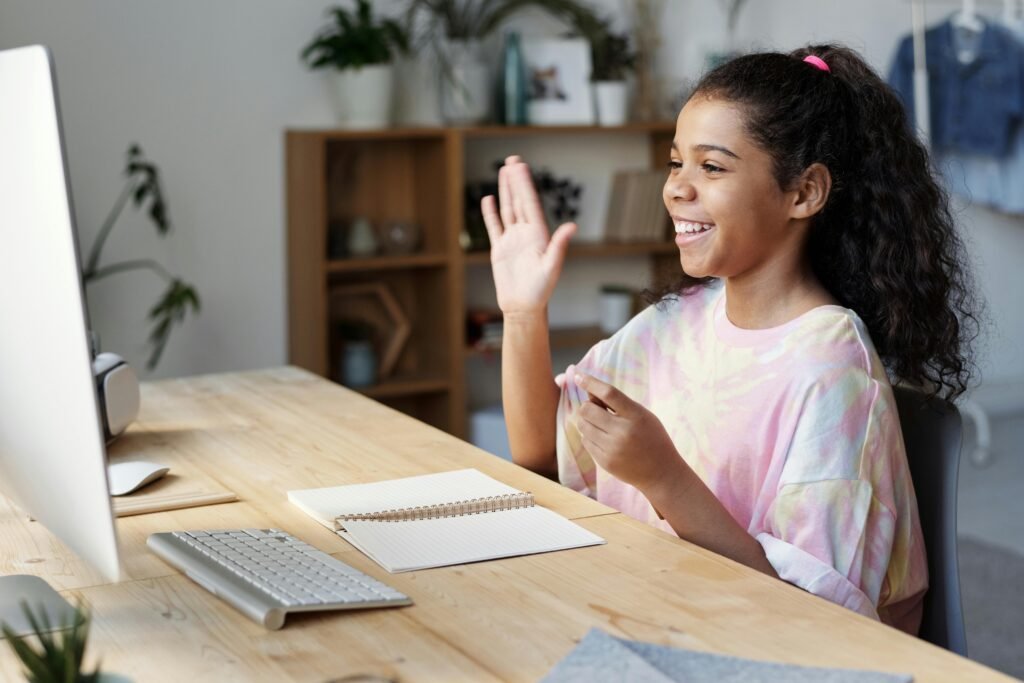
Also, get regular eye checkups. Eye strain can sometimes hide real vision issues. And if your child wears glasses, ask about blue light filters or anti-glare lenses.
Debsie courses are created to be gentle on young eyes. We use larger fonts, soft colors, and clear visuals to reduce strain. And we build in natural pauses, so kids aren’t stuck staring at one screen forever.
Your child’s eyes are precious. Let’s help them last a lifetime.
Online learners blink 50% less, which contributes to dry eye syndrome
Did you know your child may blink 50% less when they’re staring at a screen? That’s a big deal. Blinking keeps the eyes moist, clean, and healthy. When we blink less, especially during online lessons, it can cause a condition called dry eye syndrome.
Dry eyes might sound small, but it’s uncomfortable. It can feel like burning, stinging, or even like something is stuck in the eye. And for kids, that can be distracting, painful, and tiring—especially when it happens every day during learning time.
This happens because screens make us concentrate harder. When your child is reading something online, watching a lesson, or trying to click buttons quickly, their brain tells their body to “focus”—and blinking slows down. It’s almost like the body forgets to do it.
So what can you do? First, help your child remember to blink. Yes, really! Blinking exercises are simple and fun. Try this: every half hour, take a short break and have a “blinking race”—who can blink 10 times slowly without stopping? It sounds silly, but it works.
Second, keep screens at eye level—not too high, not too low. When screens are too high, kids open their eyes wider, which dries them out faster. And make sure there’s no fan or AC blowing directly on their face.
Encourage screen-free play after school. Let them go outside, play with toys, do a puzzle, or draw. This gives the eyes a chance to reset.
Debsie’s platform includes screen-time prompts that help children pause naturally during lessons, keeping their body and eyes happy. We’re not just here to teach—we’re here to protect young learners too.
52% of online students report frequent headaches linked to screen use
Here’s another important sign that something’s off—52% of online students report having frequent headaches tied to screen time. That’s more than half of all students learning online. Imagine trying to concentrate while your head pounds. It’s hard for adults—and even harder for kids.
These headaches often come from looking at screens for too long without rest. They can also happen when the lighting is too harsh, the screen is too bright, or if the child is straining to read small text or poorly designed layouts.
Sometimes it’s not even about the eyes. Sitting too long in one position, especially with poor posture, can cause tension headaches in the neck and shoulders. These spread up to the head and make everything feel worse.
To help with this, check your child’s screen setup. Is the screen at eye level? Are they sitting up straight? Is the chair comfortable with good back support? A good setup can prevent posture-related pain.
Next, adjust the screen itself. Turn on “night mode” or “warm light” settings. Lower the brightness to a comfortable level. Increase the font size so they don’t have to squint.
And don’t forget hydration! Dehydration can make screen-related headaches worse. Keep a water bottle nearby and remind them to sip often.
If headaches keep coming back, track when they happen. Is it after a certain subject? After a long lesson? Share this pattern with your teacher or learning platform. At Debsie, we take feedback like this seriously and offer ways to adjust lessons based on your child’s comfort.
A clear head leads to clear learning. No child should suffer just to keep up.
In-person students report only 18% experiencing headaches from screen use
Now compare that to this number—only 18% of in-person students report headaches from screen use. That’s a big drop from the 52% of online learners. Why the difference?
It comes down to variety. In in-person classrooms, students switch between talking, writing, moving, and using screens. That mix of activities gives the brain and body a chance to reset between tasks. Screens are just one part of the day, not the whole thing.
Also, teachers in classrooms often notice when a student is uncomfortable. They can give a short break, walk around to help, or simply pause a lesson if students look tired or restless. Online, that’s much harder to do.
For parents of in-person learners, this stat should still be a reminder. Just because headaches are less common doesn’t mean they never happen. If your child uses screens at school and then comes home to more screens—like homework, games, or videos—it can still add up.
The solution? Use home time to balance out screen time. Encourage physical activities after school. Do homework on paper if possible. Read books before bed instead of watching videos. These small shifts can protect your child’s head and help them feel better all around.
At Debsie, even for online learners, we mimic this in-person rhythm by mixing screen work with real-world challenges, movement breaks, and brain resets. Because it’s not just about content—it’s about how the body feels while learning.
47% of teachers feel that long screen hours reduce student engagement in virtual lessons
Let’s not forget the teachers. Nearly 47% of educators say that long screen hours lead to lower student engagement during online lessons. In other words, kids tune out. They get bored. They stop caring.
This isn’t because the lessons are bad. It’s because the format can get tiring. When everything is on a screen—talking, reading, clicking, writing—kids start to zone out. Especially younger ones who are used to touching, playing, and exploring in 3D.
Teachers see this every day. Kids who were once excited become silent. They turn off their cameras. They stop asking questions. This lack of engagement slows down learning and makes it harder to remember anything.
So what’s the fix?
One part of the solution is shorter lessons. Instead of one long session, break it into small parts. Do 20 minutes, then take a 5-minute break. This gives the brain a chance to reset.
Another tip is variety. If your child is learning online, mix video with audio, reading with games, typing with talking. Let them use their voice, not just their keyboard. Use flashcards, paper notes, or even physical toys to explain ideas.
Ask teachers or platforms what they’re doing to keep lessons fresh. At Debsie, we’re constantly updating our methods. We use characters, stories, rewards, and voice-based interaction to make lessons feel alive. Learning should feel like an adventure—not just a task.
If your child is zoning out during lessons, don’t blame them. It’s a sign their brain is asking for a new approach.
Kids aged 8-12 in online schooling see a 200% increase in screen time compared to pre-COVID schooling habits
Here’s a jaw-dropping fact: kids aged 8 to 12 doing online learning now have a 200% increase in screen time compared to before the pandemic. That means their screen exposure has tripled in just a few short years.
Before COVID, these kids may have spent a couple of hours a day on screens—maybe for homework, cartoons, or games. But once schooling moved online, everything shifted. Now, from morning till late afternoon, screens are the main way they learn, interact, and work. Add entertainment time, and it’s no wonder screen hours skyrocketed.
This change wasn’t gradual. It happened almost overnight. And many kids haven’t had time to adjust. Their brains, eyes, and bodies are still learning how to cope with this much digital input.
Parents often say, “My child used to be so active, but now they just sit at a screen all day.” And that’s not surprising. When so much learning is passive—watching, listening, clicking—children lose chances to move, explore, and get curious through play.
So what’s the next step?
Look for ways to reconnect your child with the offline world. Try mixing screen learning with real-life learning. For example, if they’re studying plants, go outside and look at leaves. If they’re doing math, use measuring cups in the kitchen.
Help them rediscover offline fun too. Board games, art, sports, and outdoor adventures build the brain just as much as online lessons do. They also help with focus, patience, and memory.
At Debsie, we don’t just track screen hours—we build in real-life challenges that let kids learn with their hands, hearts, and heads. We believe the best learning happens when it’s rooted in the real world.
Tripled screen time doesn’t have to be your child’s new normal. You can bring balance back, one joyful moment at a time.
Sleep quality drops by 30% among students with 6+ daily screen hours
Now let’s talk about sleep. Students who spend 6 or more hours on screens each day often see a 30% drop in sleep quality. That means they don’t fall asleep as easily, don’t stay asleep as long, and don’t feel rested when they wake up.
Sleep is everything for growing kids. It helps with focus, memory, mood, and health. Poor sleep leads to cranky mornings, brain fog, and emotional ups and downs. And many parents don’t realize screen time might be the cause.
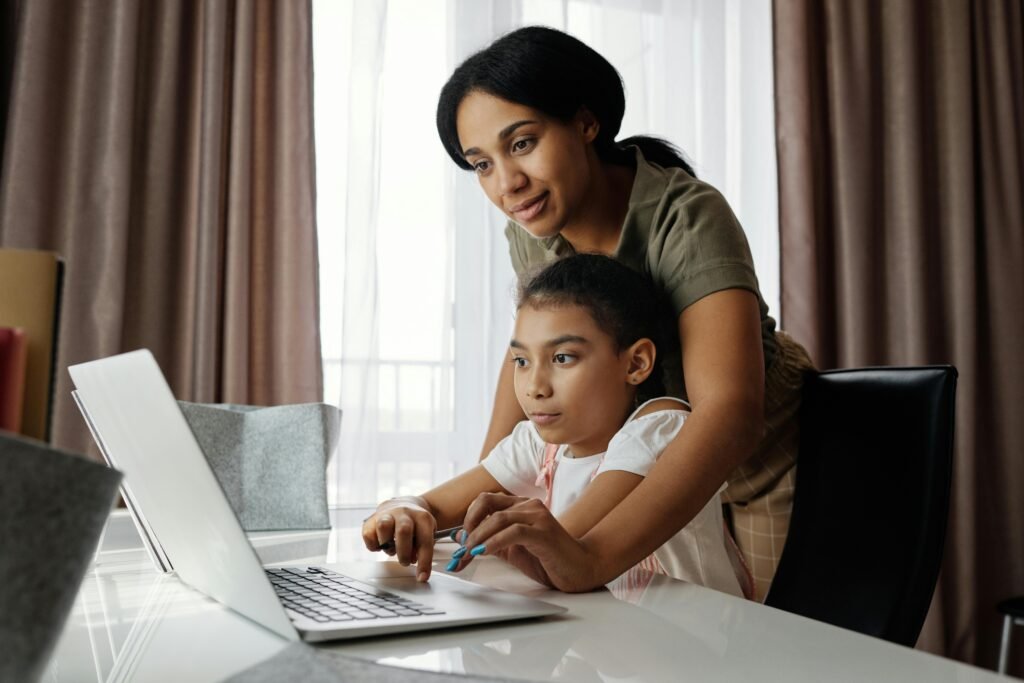
Why does this happen? It’s mostly because screens give off blue light. This light tricks the brain into thinking it’s still daytime. So when your child watches a screen close to bedtime—whether it’s a lesson, a game, or a video—their brain holds off on producing melatonin, the hormone that makes them sleepy.
Add in the mental stimulation from games or video calls, and bedtime becomes a battle.
What can you do?
First, create a wind-down routine with zero screens at least one hour before bedtime. Turn off TVs, tablets, and phones. Instead, try reading a book, listening to soft music, or doing gentle stretches.
Second, use settings to reduce blue light in the evening. Most devices have a “night mode” or “warm light” option. This shifts the color of the screen to be gentler on the eyes and less likely to delay sleep.
And finally, talk about sleep with your child. Help them understand why it matters. Make it something they want to protect—not just something they’re forced to do.
Debsie lessons are designed to be done during the day, not at night. We keep sessions short, purposeful, and fun—so your child can enjoy learning, then power down peacefully when the day is done.
25% of online students report trouble falling asleep after long screen exposure
Going even deeper into the sleep topic: 1 in 4 online students say they struggle to fall asleep after using screens for school. That’s a quarter of kids tossing and turning in bed, even when they’re tired.
Falling asleep isn’t just about being sleepy. It’s about the brain slowing down, the body relaxing, and the mind feeling safe and calm. But when the last few hours of your child’s day are filled with bright screens, fast-paced games, or stressful online tasks, it becomes harder to shift into sleep mode.
Online lessons—especially when they run late—can keep the brain active. If your child is doing assignments at night, using their laptop in bed, or watching stimulating videos before sleep, that quiet switch-off doesn’t happen.
To help, make a “digital bedtime.” This is a time when all screens go away, and calm, screen-free activities begin. It could be puzzles, reading together, talking about the day, or drawing in a journal.
If your child absolutely needs a screen later in the evening, make sure it’s a calming activity. No fast movements, no loud sounds, no high-stress games. Use warm colors and low brightness.
You can also help them relax their body. Try breathing exercises, a warm bath, or simple yoga stretches to help shift their energy.
At Debsie, we understand the power of rhythm. Our lessons help kids build focus during the day and leave space for true rest at night. Because healthy learning includes healthy sleep.
In-person students average 2.7 fewer screen hours per day than online counterparts
Here’s one of the clearest comparisons yet. On average, in-person students spend about 2.7 fewer hours each day on screens than kids learning online. That’s nearly three full hours to use their eyes, hands, and minds in the real world.
This gap matters. Fewer screen hours mean more room for movement, interaction, and rest. It also means less risk of eye strain, headaches, and emotional burnout.
In-person learning naturally creates these breaks. Kids walk between classes. They do art, play sports, work in groups, and use physical materials. Their day is broken into smaller chunks with different kinds of input.
As a parent, you can try to recreate some of that structure at home—even during online schooling. Start with a daily schedule that includes non-screen tasks like cleaning up, helping cook, going for a walk, or doing crafts.
Also, rethink how assignments are done. Could that science project be drawn by hand instead of made in Google Slides? Could math be solved using real-life objects instead of an online calculator?
Every screen-free moment adds up. It gives the brain a rest and opens the door for more meaningful learning.
Debsie’s lessons are built to be flexible. You can pause, stretch, do a challenge off-screen, then return. We designed it that way—because kids need freedom, not just screen time.
Online learners take 40% fewer physical activity breaks than in-person students
Here’s a stat that says a lot without saying much: online learners take 40% fewer breaks that involve moving their bodies, compared to kids in regular classrooms. That’s almost half as many chances to stretch, run, and reset.
Think about a traditional school day. Kids walk between rooms. They stand for group activities. They go to recess. They play games in PE. All of this movement isn’t just about fun—it helps the brain process and remember what it’s learned. It resets attention. It boosts mood.
Now picture online learning. A child sits in the same chair for hours, clicking through slides or watching a teacher talk. There’s often no signal to get up. No classmates running around. No bell for recess. So kids just… stay seated.
That lack of movement leads to sluggish thinking. The body gets stiff. The eyes get tired. And focus becomes harder to hold. Even if your child is learning good content, their body is working against them.
Here’s how you can change that at home. Set a “move timer” every 25–30 minutes. When it goes off, have your child stand up, jump around, do a silly dance, or take a lap around the house. It doesn’t have to be long—just 2 to 5 minutes of movement resets the body and mind.
Also, build in larger breaks between longer learning sessions. After two subjects, maybe it’s time for a snack walk or bike ride. If your child resists, join in! Kids often follow your energy.
At Debsie, we bake physical challenges right into the lessons. We might say, “Run and grab three things that are circles!” or “Do five jumps before you answer this question.” It keeps the brain fresh and the body engaged.
Movement is learning. Let’s not leave it out just because the classroom is now a screen.
60% of online students use screens for multitasking, increasing screen exposure unnecessarily
Let’s talk about something sneaky: multitasking. Around 60% of online students use screens for more than one thing at a time during lessons. Maybe they’re watching a YouTube video while doing math. Or flipping between a Zoom call and a game. Or chatting with friends while reading.
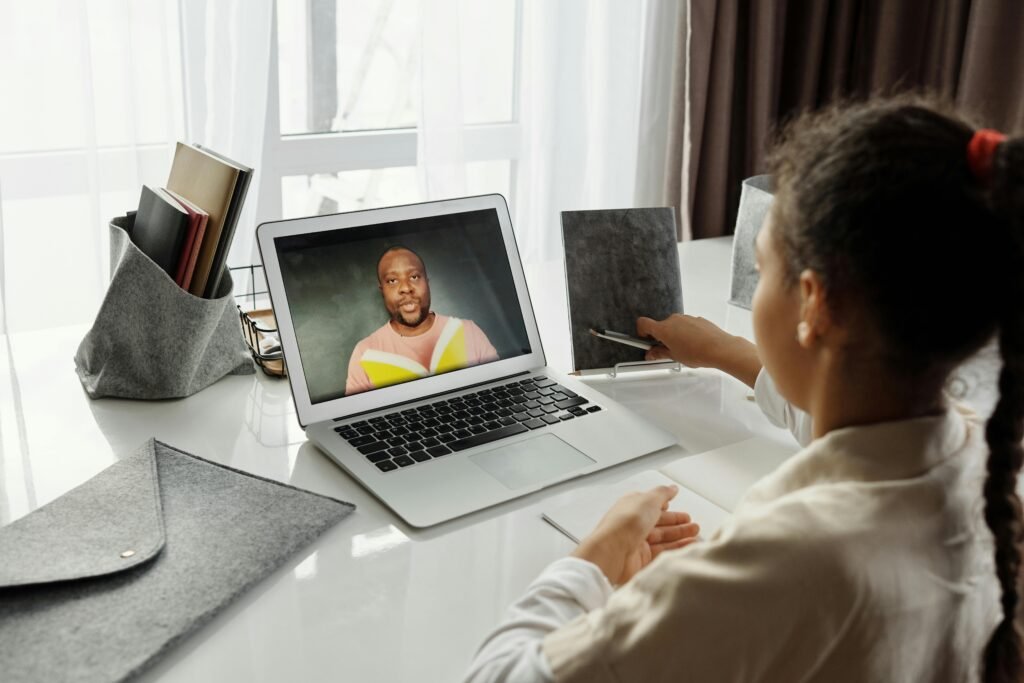
It might look like they’re being productive. But in truth, this kind of multitasking doesn’t save time—it actually makes learning harder. It adds to screen exposure without adding real value.
The brain can only focus on one thing at a time. When a child flips between tabs, apps, or screens, their attention is split. This increases mental fatigue, causes mistakes, and makes it harder to remember what they’re learning. It also means they spend even more time online to finish tasks they could’ve done faster with full focus.
So how can you stop this cycle?
First, check the learning environment. Is your child’s device set up for learning only? Close non-school apps. Use full screen to reduce distractions. If possible, use apps that block social media or YouTube during class time.
Next, talk about it. Explain what multitasking really does to the brain. Kids don’t always know that switching tabs 20 times makes things slower. Teach them to work in focused blocks—20 minutes of full attention, then a break.
At Debsie, we design lessons to be clear, short, and engaging—so students don’t feel the need to multitask. Our content holds their focus naturally, with fun hooks and interactive steps that make them want to stay in the moment.
Multitasking isn’t a superpower. It’s a trap. And helping your child focus on one thing at a time is one of the best gifts you can give.
92% of in-person schools limit device use to lesson-specific activities
Here’s a stat that explains a big difference in learning environments: 92% of in-person schools only allow devices to be used for specific lesson activities. That means screens are tools—not the main space where everything happens.
When a screen is only used to show a short video, explain a hard concept, or do a quick search, it stays helpful. It supports learning without taking over. Kids then return to paper, conversation, or hands-on tasks. This balance keeps the brain more alert and the learning experience richer.
In online learning, however, the screen becomes the whole school. It’s the notebook, the chalkboard, the textbook, and the classroom—all in one. That’s where trouble starts.
So what can we learn from traditional schools?
We can bring this “use only when needed” mindset into our homes. Try setting times when screens are part of the lesson—and times when they’re not. For example, your child can watch a math video for 10 minutes, then do the rest of the problems on paper.
You can also separate work spaces. Maybe the computer stays on the desk, and all off-screen tasks happen at the kitchen table or on the floor. Even moving between spaces gives the body a break and helps the brain shift gears.
Debsie lessons are structured in a way that lets parents and kids break up screen time with real-world tasks. Our platform guides students when to be on-screen and when to step away. Because sometimes, less is more.
Screens should help learning—not hold it hostage.
40% of online school time is spent passively watching vs. interacting
Here’s a surprising stat: 40% of online school time is spent just watching—not doing, not talking, not solving, just passively absorbing content. That’s nearly half of learning time spent in a way that doesn’t fully activate the brain.
Passive watching happens when students sit through long lectures, watch pre-recorded videos, or scroll through slides with no real interaction. It can feel like learning—but it doesn’t stick. Without doing something with the knowledge, most of it is forgotten.
Why does this happen? Because making interactive lessons takes time. It’s easier to record a video or post slides than it is to design an activity or game. But the tradeoff is huge. Kids become less engaged. They start zoning out. They stop learning.
So how do we shift from passive to active?
Ask your child what they’re doing in class. Are they just watching? Or are they also solving, creating, writing, or discussing? If it’s mostly passive, start adding small active moments. Pause videos and ask questions. Have them draw what they just learned. Or let them teach it back to you in their own words.
If you’re picking an online learning program, choose one that includes interaction—not just content. At Debsie, we’ve made interaction our foundation. Every few minutes, we ask students to act, solve, move, or decide. We don’t just deliver information—we help kids build with it.
Learning isn’t a show. It’s an experience. And every child deserves to be an active part of it
Students attending online school have 15% higher risk of attention fatigue
Attention fatigue is real—and kids learning online are 15% more likely to struggle with it. That means they find it harder to concentrate, stay focused, or finish tasks without drifting off mentally. It’s not that they’re lazy. Their brains are just tired.
Screens, especially for long periods, ask the brain to stay alert in an unnatural way. Bright lights, fast visuals, and constant clicking don’t give the mind a chance to slow down and process. In an in-person setting, the variety of movement, sounds, and real-life interaction resets attention naturally.
When kids do six hours of screen-based lessons in a row, their attention system starts to wear out. It’s like a muscle that’s been overused without rest. They may start a lesson full of energy, but by the third or fourth hour, they’re just going through the motions—or zoning out completely.
What’s the fix?
You guessed it: breaks. Not just any breaks, but the right kind—physical, playful, and away from screens. Think five minutes of stretching, dancing, or jumping jacks after each lesson. Or a quick outdoor walk between subjects.
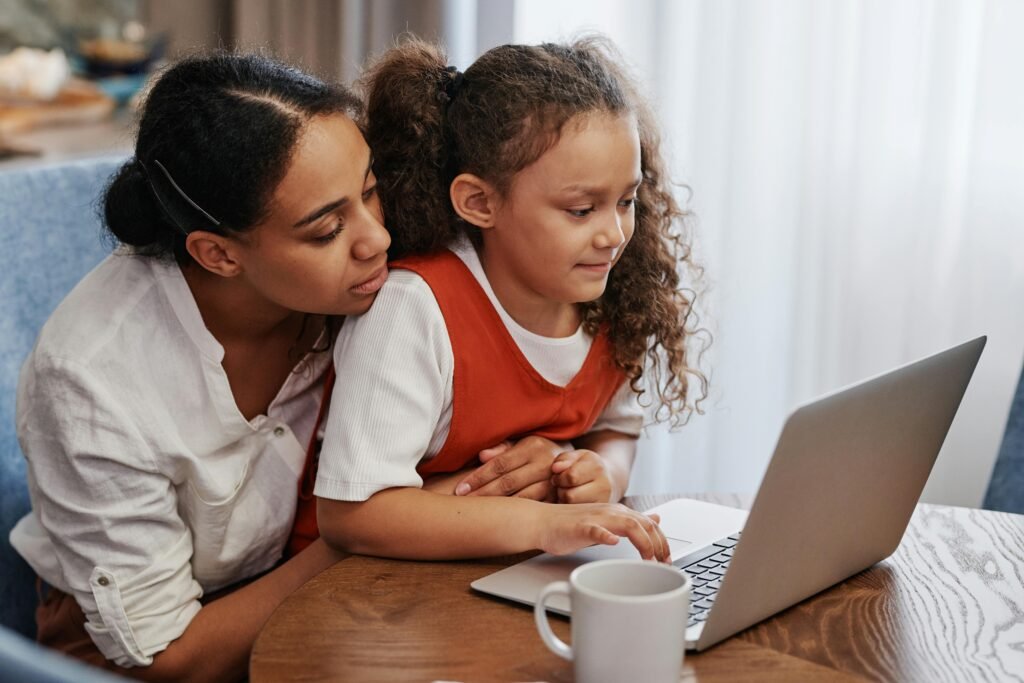
Also, break learning into small, digestible chunks. If your child has a one-hour lesson, split it into two 25-minute blocks with a fun 10-minute break in between. This keeps the brain fresh and reduces that mental “fog.”
At Debsie, we design all our lessons with brain breaks built in. We don’t expect kids to sit still for hours. Our platform helps them reset, refocus, and come back stronger.
Attention is precious. Let’s protect it with smart pacing, screen balance, and plenty of joy.
75% of parents report screen time as their top concern with online learning
When asked what worries them most about online school, 75% of parents say screen time is their biggest concern. And it’s not hard to see why.
They see their child’s tired eyes. The stiff posture. The quiet dinners where everyone’s still glued to a device. They hear the stories of headaches, sleep issues, and short tempers. And they wonder, “Is this really good for my child?”
These concerns are valid. Screen time isn’t bad on its own—but too much, used the wrong way, can do more harm than good. Especially when learning, which should be joyful, hands-on, and full of life, starts to feel flat and tiring.
If you’re one of these parents, you’re not alone. And you’re not powerless, either.
Start by talking to your child about how they feel during and after lessons. Look for signs of fatigue, restlessness, or frustration. Then take simple steps to add balance. Encourage movement between lessons. Replace some screen-based tasks with creative or physical ones.
Also, work with your child’s learning provider. Ask what they’re doing to reduce screen fatigue. At Debsie, we love hearing from parents—and we’ve built our curriculum based on their feedback. Our mix of active lessons, off-screen challenges, and optional printable tasks is designed to ease screen stress while still delivering top-notch learning.
Being concerned is a good thing. It means you care. Let’s turn that care into action and give your child the healthiest, happiest learning experience possible.
Digital fatigue affects 3 in 5 online learners by midweek
Let’s talk about digital fatigue—that heavy, drained feeling kids get when they’ve been on screens too long. By the middle of the week, 3 in 5 online learners say they feel this way.
It shows up as slouching, irritability, loss of interest, slow response times, and even physical complaints like headaches or eye strain. Some kids get unusually quiet. Others get moody or easily frustrated.
This fatigue isn’t just physical—it’s emotional and mental, too. When the brain has been over-stimulated for days in a row, with little variety or recovery time, it starts to push back. Kids lose motivation. They may stop engaging. And learning slows down.
Midweek fatigue means the system needs a reset.
One helpful tactic is to shift the structure of your week. Make Wednesdays (or whatever day your child tends to feel most drained) a lighter day. You can focus more on hands-on activities, reviews, or creative tasks. Give the brain a break from constant input.
Also, schedule fun screen-free time midweek. This could be baking, drawing, playing outside, or going on a short outing. Changing the pace helps the brain recharge.
At Debsie, we structure our week with variety in mind. Some days are challenge-heavy, others are exploration-focused, and we always leave space for rest and joy. We never want a child to feel like learning is a grind.
Fatigue is a signal. Let’s listen to it—and make learning feel light again.
Eye strain complaints increase by 25% after just 3 continuous hours of screen use
After just three straight hours on a screen, the number of kids reporting eye strain jumps by 25%. That means even if your child is fine for the first hour or two, once they cross that line, things change fast.
Eye strain might feel like dry eyes, burning, blurriness, or just that heavy, tired eye feeling. Kids might not always say it out loud, but you’ll notice the signs: rubbing eyes, blinking more, or losing focus on the screen.
Three hours might not seem like much—but in a typical online school day, it’s easy to hit that number before lunch. And that’s not counting extra screen time in the afternoon for homework or fun.
So what can you do?
First, limit continuous screen time to 45–60 minutes per block. After each block, take a 5–10 minute break. Encourage your child to look out the window, stretch, or close their eyes for a bit.
Next, use tools to reduce strain. Turn on “eye comfort” settings. Increase font size. Adjust contrast to make reading easier. And be sure screens aren’t too close to the face—an arm’s length away is ideal.
Also, teach your child the 20-20-20 rule: every 20 minutes, look at something 20 feet away for at least 20 seconds. It’s a small habit that can make a big difference.
At Debsie, we’ve made every visual element easy on young eyes. Big text. Clear graphics. Calming colors. We’ve designed it all with care—because eyes matter.
Learning shouldn’t hurt. Let’s protect those little eyes, one smart habit at a time.
In-person learners spend 50% more time outdoors daily than online learners
There’s something simple but powerful about this one: in-person students spend about 50% more time outdoors each day than their online-learning peers. That’s fresh air, sunshine, and space to move—and kids need it more than ever.
Outdoor time helps children in more ways than people often realize. It boosts mood, sharpens focus, lowers stress, and helps with sleep. It also supports physical development—strong bones, better coordination, and healthy vision. Not to mention, it builds creativity and social skills through unstructured play.
So why do online learners get less?
Most online students don’t have built-in breaks to go outside. There’s no playground period, no walk to class, and no recess bell. Their “school” is just a screen in a room, and when class ends, they often stay put—watching YouTube or doing homework online.
The good news is, you can change that.
Make outdoor time part of your family’s daily rhythm. Even 20 minutes outside after a lesson can refresh your child’s body and brain. It doesn’t have to be a big outing. A short walk, a bit of backyard play, watering plants, or doing homework under a tree all count.
Use movement as a break between subjects. If your child learns math inside, do reading time outside. If they’ve just watched a long science video, go out and look for bugs, leaves, or clouds that match the topic.
At Debsie, we even include challenges that ask children to “go outside and find something interesting” or “draw a shape you see in nature.” We encourage off-screen curiosity because real learning doesn’t just happen behind a desk.
Every minute outdoors adds something special to a child’s day. Let’s make sure they get it.
Children under 10 are particularly vulnerable to screen-induced sleep and focus problems
Younger kids—especially those under 10—are more sensitive to the effects of screen time. Studies show they’re especially vulnerable to problems with sleep and focus when exposed to screens for long periods.
Why? Because their brains are still building the patterns that support attention, self-regulation, and sleep cycles. Their natural rhythms can be thrown off more easily by bright light, fast-paced content, and long sitting sessions. A teenager might bounce back quickly from a late-night screen session, but for a 7-year-old, it could mean crankiness and tired eyes all the next day.
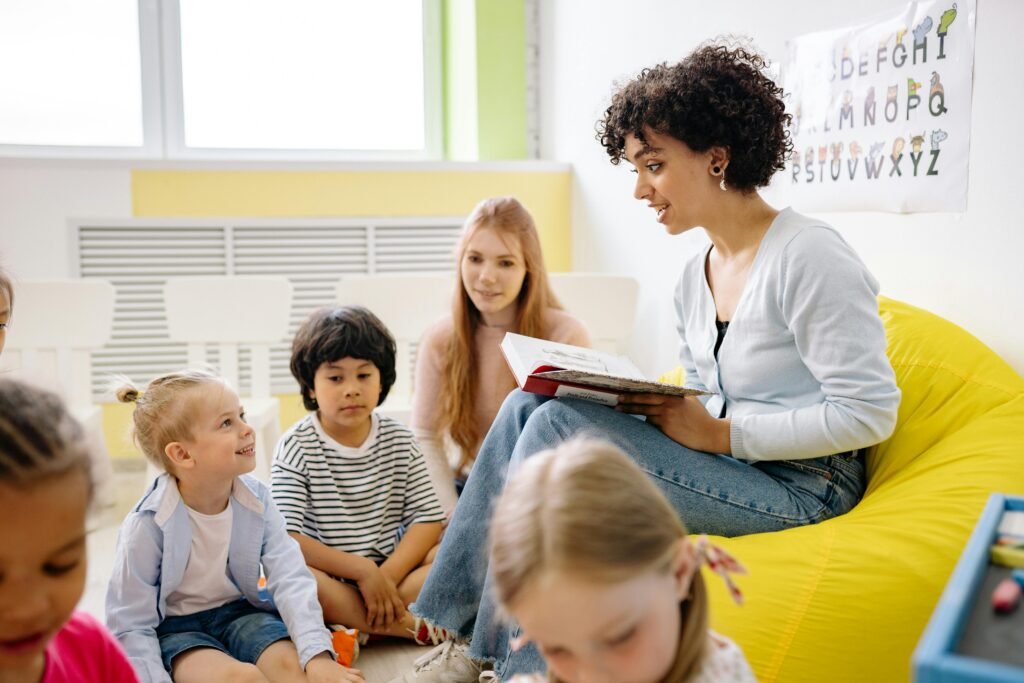
Parents often notice it without realizing it’s from screens. Maybe your child is having a harder time paying attention in lessons. Or maybe bedtime is getting later and later, with more restlessness. These are common signs.
So how do you help?
Start by creating strong screen boundaries—especially around bedtime. No screens in the bedroom. No digital play right before sleep. Replace evening screen time with quiet reading, storytelling, or calming music.
During the day, balance screen-based lessons with physical tasks. If the lesson is on shapes, have your child find and trace shapes around the house. If they’re learning to spell, try a spelling game with blocks or letter cards.
Younger kids need to use their hands, bodies, and voices—not just their eyes. That’s how they anchor what they learn.
Debsie lessons for younger learners are designed with this in mind. We use plenty of audio, hands-on challenges, and short bursts of activity to match how little brains grow best.
Protecting focus and sleep in early years pays off for life. Let’s get those habits right from the start.
Blue light exposure from screens delays melatonin release by up to 1.5 hours
Here’s some science that really matters: blue light from screens can delay your child’s release of melatonin—the sleep hormone—by up to 1.5 hours. That means even if your child wants to fall asleep at 8:30, their body might not be ready until 10.
This is especially true if they’re on screens right before bed. Tablets, phones, and computers all give off a cool, blue-toned light that tricks the brain into thinking it’s still daytime. This keeps the brain alert when it should be winding down.
Over time, this sleep delay affects mood, learning, and even growth. Sleep is when the brain does its deep cleaning. It files memories, builds skills, and resets for the next day. If your child isn’t getting enough of it, they’re starting every morning on empty.
What can you do?
Create a “no screen zone” at least one hour before bed. This includes not just learning time but also entertainment. Swap video time for a bath, some coloring, soft music, or reading aloud. If they’re old enough, let them journal about their day.
Also, adjust screen settings. Most devices allow you to schedule a warm light filter after a certain time of day. Use this! It reduces the blue light and helps melatonin kick in more naturally.
At Debsie, we suggest that parents complete lessons earlier in the day whenever possible. Our platform doesn’t push late-night sessions, because we value sleep just as much as learning.
Your child’s brain needs deep rest to grow deep skills. Protect that bedtime.
31% of online students report increased irritability tied to long screen sessions
Let’s talk about moods. Around 31% of students learning online say they feel more irritable after long screen sessions. And if you’re a parent, you’ve probably seen this too.
Your child might start a lesson calm and focused, but by hour three, they’re grumpy, snappy, or zoned out. They may resist doing anything else. They might complain more. Or they just seem “off.”
This irritability isn’t just about being tired. It’s often tied to mental overload. Screens deliver information fast, nonstop. There’s little time to pause, process, or recover. Add the stress of trying to keep up, and it’s no wonder emotions get frayed.
The fix here is not just less screen time—but better screen time.
Make sure your child is using screen time that’s purposeful, not just passive. The more engaging and interactive the lesson, the less likely it is to trigger frustration. Keep sessions short, clear, and positive.
Also, give them a safe space to vent. Sometimes a quick chat after a lesson—“Was that fun? Was it too long?”—can help them process what they’re feeling. Don’t jump to “cheer up”—just listen.
Then, shift the energy. After a long screen block, do something playful and human. Tell a joke. Play a game. Do something physical. This “reset” clears the irritation and rebuilds emotional balance.
Debsie lessons are paced and structured to reduce digital tension. We use humor, storytelling, and breaks to keep things light. Because learning should feel good—not overwhelming.
28% of students in virtual classes admit to feeling “zoned out” due to screen overuse
Last stat for this set—28% of online students say they feel completely “zoned out” at some point during virtual learning. That means the brain is present, but not really there. It’s not absorbing, not engaging, just running on autopilot.
Zoning out is more than just boredom. It’s a sign that the brain is overwhelmed, understimulated, or both. Kids may stare at the screen, but nothing’s going in. That’s a waste of time—and a risk to confidence too.
When kids feel like they’re “not getting it,” they start to believe they’re not smart. But often, the problem isn’t the child—it’s the system.
What’s the solution?
Bring variety into every learning session. Switch between watching, doing, listening, building, and talking. Even small changes—like standing up while answering questions—can help reset the brain.
Use questions to keep attention alive. After a video, ask, “What was your favorite part?” or “What was confusing?” This pulls kids back into active thinking.
You can also use body cues to catch the zone-out moments. If your child is slouching, yawning, or not reacting, it might be time to pause. Even a short dance break or a snack can restart the system.
Debsie was built to fight zone-out moments. We use energy bursts, challenge cards, sound cues, and lots of interaction. The result? Kids stay curious and awake—right to the end.
Learning is an adventure. No one should sleepwalk through it.
High screen time is associated with a 23% decrease in memory retention compared to more hands-on learning
Here’s a stat that really matters: high screen time is linked to a 23% drop in memory retention compared to hands-on learning. That means when students only learn through screens, they remember less of what they studied.
Memory works best when we’re doing something—not just watching or reading. Think of it like this: watching someone ride a bike doesn’t help you learn how to ride. You have to get on the bike. The same goes for school subjects. Children remember more when they use multiple senses—touching, building, saying, drawing, even acting out what they learn.
But screens limit this. Most online lessons involve watching, listening, and maybe typing. Those are only a few brain pathways. Without movement or deeper interaction, information doesn’t “stick.” It just floats by.
So, how can you help your child remember what they learn?
After each lesson, ask them to teach it back to you. If they can explain it in simple terms, they understand it. If they struggle, it’s a chance to review together.
Add action to the lesson. If the topic is science, do a simple home experiment. If it’s a new word, use it in a sentence or draw a picture of it. Make it physical, playful, or creative.
Also, repeat. Repetition builds memory. But instead of watching the same video again, ask your child to quiz themselves. Or tell a story that includes what they just learned. Even silly songs help cement ideas!
Debsie lessons are packed with memory-friendly tools. We use mini-games, challenges, and active recall to make sure kids aren’t just learning—they’re remembering. Our goal isn’t fast content. It’s deep, lasting understanding.
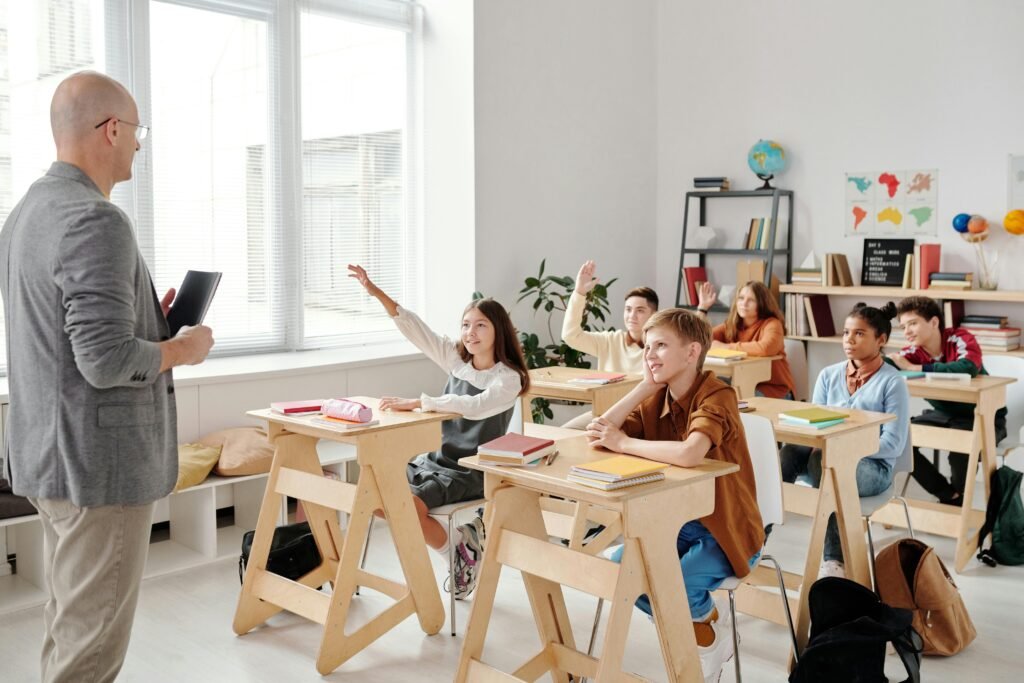
Because real learning stays with you. And that’s what matters most.
Conclusion:
Let’s face it—screens aren’t going anywhere. They’re part of how we live, work, and learn. But as this article has shown, how we use screens matters far more than how much.
We’ve looked at 30 powerful stats that reveal the real impact of online vs in-person learning—on eyes, brains, bodies, and hearts. We’ve seen how extra screen hours affect sleep, memory, attention, emotions, and more. And through it all, one clear message stands out:
